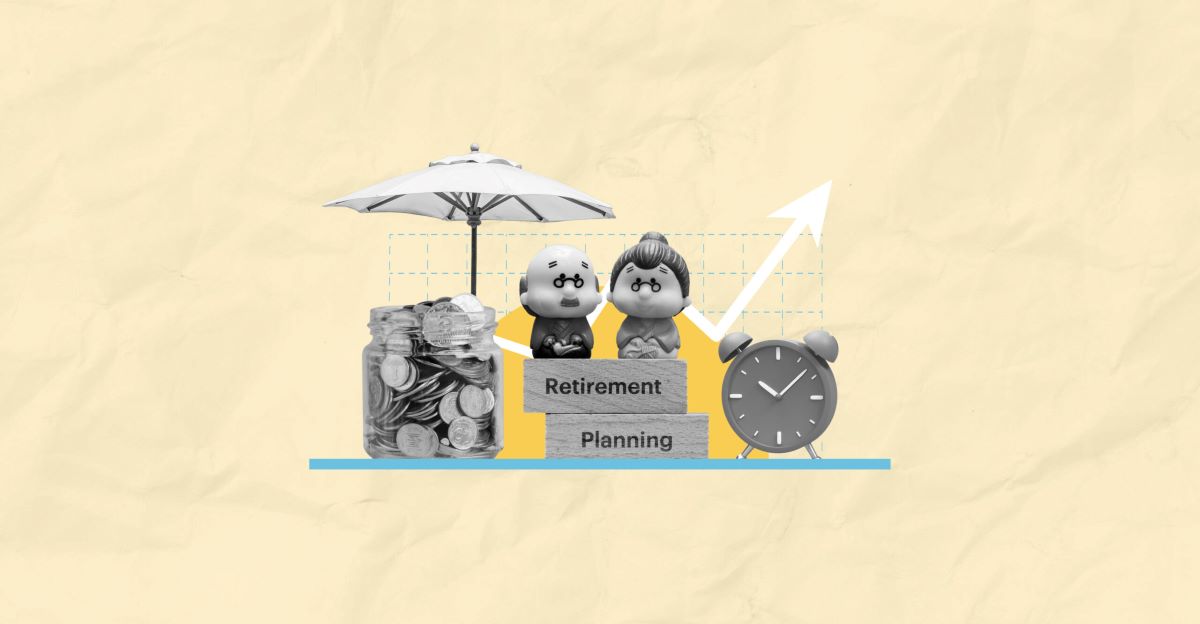Home>Finance>What Are The First Steps Of Retirement Planning


Finance
What Are The First Steps Of Retirement Planning
Published: January 21, 2024
Get your finances in order with the first steps of retirement planning. Start planning for a secure and comfortable future today.
(Many of the links in this article redirect to a specific reviewed product. Your purchase of these products through affiliate links helps to generate commission for LiveWell, at no extra cost. Learn more)
Table of Contents
- Introduction
- Assessing Financial Situation
- Setting Retirement Goals
- Creating a Budget
- Understanding Retirement Accounts
- Evaluating Social Security Benefits
- Assessing Health Insurance Options
- Determining Retirement Income Sources
- Calculating Retirement Expenses
- Creating an Investment Strategy
- Considering Long-Term Care
- Updating Estate Planning
- Reviewing and Adjusting the Plan
- Conclusion
Introduction
Retirement planning is an essential part of financial management, ensuring a secure and comfortable future for individuals. It involves a series of steps and considerations to assess one’s financial situation, set retirement goals, and create a comprehensive plan to achieve them. Effective retirement planning helps individuals make strategic financial decisions to sustain their lifestyle and enjoy financial freedom during their golden years.
This article will guide you through the first steps of retirement planning, providing valuable insights and practical tips. By following these steps, you can start building a solid foundation for a successful retirement.
Before diving into the details, it’s important to recognize that retirement planning is a personalized process. Everyone’s financial situation, goals, and objectives are unique, so it’s essential to tailor your plan accordingly. Consulting with a financial advisor or retirement planner can further enhance your understanding and help you make informed decisions.
Now, let’s explore the first steps of retirement planning in more detail, laying the groundwork for a secure and fulfilling retirement.
Assessing Financial Situation
The first step in retirement planning is to assess your current financial situation. This involves taking stock of your income, expenses, assets, and liabilities. By understanding your financial picture, you can make informed decisions about how much you need to save and what steps you need to take to secure your retirement.
Start by evaluating your income sources. This includes your salary, investments, rental income, or any other sources of income you may have. Note down the total amount you receive each month or year.
Next, assess your expenses. This involves tracking your monthly spending to gain a clear understanding of where your money goes. Break down your expenses into categories such as housing, transportation, groceries, entertainment, and healthcare. This will help you identify areas where you can potentially cut back to save more for retirement.
Once you have a clear picture of your income and expenses, calculate your net worth. Subtract your liabilities (such as outstanding loans and credit card debt) from your assets (such as savings, investments, and property). This will give you a snapshot of your overall financial health.
Additionally, consider any outstanding financial obligations you may have, such as paying off a mortgage or supporting dependents. These factors will influence your retirement planning strategy and the amount of money you need to sustain your lifestyle post-retirement.
Lastly, evaluate your risk tolerance. It’s important to understand how comfortable you are with investment volatility and potential losses. This will help determine the appropriate allocation of assets in your retirement portfolio.
By assessing your financial situation thoroughly, you can gain a realistic understanding of your current standing and set the stage for effective retirement planning. Remember, it’s never too early or too late to start planning for your future.
Setting Retirement Goals
Setting clear and specific retirement goals is crucial to ensure that you have a target to work towards. Retirement goals provide a roadmap for your financial planning, helping you determine how much you need to save and the timeframe in which you need to achieve those goals.
Start by considering the age at which you want to retire. This will be influenced by several factors, including your personal preference, health, and the availability of retirement benefits. Some individuals may choose to retire early, while others may opt for a later retirement age.
Next, think about the kind of lifestyle you envision for your retirement years. Consider factors such as travel, hobbies, living arrangements, and healthcare needs. This will help you estimate the financial resources you will require to maintain your desired standard of living.
Take into account any major life events you anticipate during retirement, such as buying a second home, funding your children’s education, or supporting aging parents. These events may impact your financial goals and should be factored into your retirement planning.
Additionally, consider your legacy goals. Do you want to leave an inheritance for your children or make charitable contributions? Planning for these aspects will help you shape your retirement savings and investment strategies.
Once you have identified your retirement goals, assign realistic timelines and quantify the financial requirements. For example, if you want to retire at age 65 and have a goal of traveling extensively for the first five years of retirement, estimate the expenses associated with those travel plans.
It’s important to regularly revisit and reassess your retirement goals as your circumstances may change over time. Life events, economic factors, and personal preferences may all influence your retirement goals. Being flexible and adaptable in your planning will help ensure that your goals remain aligned with your current situation.
Remember, setting retirement goals provides a sense of purpose and direction to your financial planning efforts, helping you stay focused and motivated as you work towards a rewarding and fulfilling retirement.
Creating a Budget
A budget is a fundamental tool for effective retirement planning. It allows you to track your income and expenses, prioritize savings, and ensure that you are living within your means both now and during retirement.
Start by gathering your income and expense information. Include all sources of income, such as salary, investments, and rental income. Likewise, list all of your expenses, including fixed expenses like mortgage or rent payments, utility bills, insurance premiums, and transportation costs, as well as variable expenses like groceries, entertainment, and dining out.
Once you have a comprehensive list of your income and expenses, allocate a specific amount towards retirement savings. Ideally, aim to save at least 10-15% of your income for retirement. If you’re not able to save that much initially, start with a smaller percentage and gradually increase it over time.
When creating your budget, be realistic and consider any necessary adjustments. Identify areas where you can reduce discretionary spending to allocate more towards retirement savings. This may involve cutting back on non-essential expenses or finding cost-effective alternatives.
Regularly review your budget to track your progress and make adjustments as needed. Monitor your expenses and ensure that you are staying on track with your savings goals. If you notice any deviations or unexpected expenses, make the necessary adjustments to keep your budget balanced.
Additionally, consider incorporating an emergency fund into your budget. Having a separate fund to cover unforeseen expenses can help prevent dipping into your retirement savings during emergencies, providing a safety net for your financial well-being.
Creating and sticking to a budget requires discipline and consistency. However, it’s an essential step in retirement planning, as it allows you to manage your finances effectively and make informed decisions about your retirement savings and spending.
Remember, a budget not only helps you save for retirement but also enables you to enjoy your current lifestyle without unnecessary financial stress. It sets the foundation for a financially secure future.
Understanding Retirement Accounts
Retirement accounts are key financial tools that can help individuals save and grow their money for retirement. Understanding the different types of retirement accounts available and how they work is essential for effective retirement planning.
One common type of retirement account is the 401(k). Offered by many employers, a 401(k) allows employees to contribute a portion of their salary on a pre-tax basis. The contributions grow tax-deferred until withdrawal during retirement. Some employers even offer a matching contribution, which means they will contribute a certain percentage of the employee’s salary to their 401(k) account.
Another popular retirement account is the Individual Retirement Account (IRA). There are two main types of IRAs: Traditional IRA and Roth IRA. With a Traditional IRA, contributions are typically tax-deductible, and the funds grow tax-deferred until withdrawal. On the other hand, with a Roth IRA, contributions are made with after-tax dollars, but qualified withdrawals are tax-free. Both types of IRAs have annual contribution limits, so it’s important to be aware of these limits when planning your retirement savings strategy.
In addition to employer-sponsored plans and IRAs, there are other retirement accounts available, such as Simplified Employee Pension (SEP) IRAs and Solo 401(k)s for self-employed individuals and small business owners. These accounts provide specific benefits and contribution limits tailored to the needs of these individuals.
Understanding the rules and regulations associated with each retirement account is crucial. Factors such as contribution limits, withdrawal penalties, and required minimum distributions (RMDs) vary depending on the type of account. It’s important to educate yourself about these details and consult with a financial advisor if needed.
Consider diversifying your retirement savings by contributing to multiple retirement accounts. This can help reduce the risk associated with relying on a single account and provide more flexibility in terms of tax strategies and withdrawal options during retirement.
Remember, retirement accounts offer tax advantages and opportunities for growth, making them valuable tools for building a secure retirement nest egg. Understanding how these accounts work and strategically utilizing them in your retirement planning can have a significant impact on your financial future.
Evaluating Social Security Benefits
Social Security is a government program that provides retirement benefits to eligible individuals. Understanding how Social Security works and evaluating your potential benefits is an important aspect of retirement planning.
Start by familiarizing yourself with the basic eligibility requirements for Social Security. Typically, you need to have earned a certain number of credits through your work history to be eligible for benefits. The number of credits required can vary based on your age at the time you apply for benefits.
Once you determine your eligibility, it’s important to consider the timing of when you decide to claim your Social Security benefits. You can start receiving benefits as early as age 62, but your monthly benefit amount will be reduced compared to your full retirement age. On the other hand, if you delay claiming benefits beyond your full retirement age, your monthly benefit amount will increase.
It’s crucial to evaluate your projected Social Security benefits based on your personal circumstances. The Social Security Administration provides an online tool called my Social Security, which allows you to estimate your benefits based on your earnings history and projected retirement age.
Consider factors such as your longevity, health, and other sources of income when determining the optimal age to claim Social Security benefits. You may want to consult with a financial advisor to evaluate different claiming strategies and understand how Social Security fits into your overall retirement income plan.
Keep in mind that Social Security benefits should not be relied upon as the sole source of retirement income. Supplementing your Social Security benefits with other sources such as employer retirement plans, savings, or investments is crucial for a comfortable retirement.
Evaluating your Social Security benefits and understanding how they fit into your overall retirement plan will give you a clearer picture of your income sources during retirement. It will help you make informed decisions about when to claim benefits and how to maximize the value of your Social Security benefits.
Remember, Social Security benefits are an essential component of most retirees’ income, and carefully assessing your options can optimize your financial well-being in retirement.
Assessing Health Insurance Options
When planning for retirement, it’s crucial to carefully assess your health insurance options. Understanding the costs, coverage, and eligibility criteria for different health insurance plans will help you ensure adequate healthcare coverage during your retirement years.
If you retire before the age of 65, when you become eligible for Medicare, you will need to explore other health insurance options to bridge the gap. One option is to continue your employer-sponsored health insurance through COBRA, which allows you to maintain your current coverage for a limited period of time. However, keep in mind that COBRA can be costly as you will be responsible for the entire premium.
Another option is to explore individual health insurance plans available through the Health Insurance Marketplace or private insurers. Compare different plans and consider factors such as premiums, deductibles, copayments, and prescription drug coverage. It’s important to choose a plan that suits your healthcare needs and budget.
If you have a spouse who is still working and has employer-sponsored health insurance, you may be able to join their plan. Assess the coverage and costs associated with this option to determine if it’s a viable choice for you.
Once you reach the age of 65, you become eligible for Medicare, the federal health insurance program for seniors. It’s important to carefully evaluate the different parts of Medicare – Part A, Part B, Part C (Medicare Advantage), and Part D (prescription drug coverage). Consider your healthcare needs, including any ongoing medical conditions or prescription medications, when selecting the most suitable Medicare coverage options.
Additionally, understanding the potential costs associated with Medicare, such as premiums, deductibles, copayments, and Medigap insurance, will help you budget for healthcare expenses during retirement.
Lastly, consider the potential need for long-term care insurance. Long-term care expenses can be substantial and have the potential to deplete your retirement savings. Assess the costs and benefits of long-term care insurance to determine if it’s a worthwhile investment for your specific situation.
Remember, assessing your health insurance options is an integral part of retirement planning. Adequate healthcare coverage is essential for your well-being and financial security, ensuring that you can address your healthcare needs with peace of mind during your retirement years.
Determining Retirement Income Sources
When planning for retirement, it’s important to carefully consider your sources of income. Understanding and diversifying your retirement income sources will help ensure a financially secure and comfortable retirement.
The first and most common source of retirement income is Social Security. As mentioned earlier, evaluate your projected Social Security benefits based on your earnings history and decide the optimal age to claim benefits. This will provide a steady stream of income throughout your retirement years.
Another important source of retirement income is employer-sponsored retirement plans, such as 401(k)s or pensions. If you have a 401(k), determine how much you have saved and estimate the income it will provide during retirement. If you have a pension, understand the terms and conditions, including the eligible payout options.
Income from personal savings and investments is also a crucial component of retirement income. Assess your savings accounts, brokerage accounts, and other investment vehicles to determine how much income they can generate. Consider factors such as interest rates, dividends, and potential capital gains from your investments.
Rental income from real estate investments can be another source of retirement income. If you own rental properties, assess their potential rental income and expenses to determine the net cash flow that can contribute to your retirement income.
Additionally, if you plan to continue working during retirement, consider the income you can generate from part-time or freelance work. Although it may not be the primary source of income, it can supplement your retirement funds and provide financial flexibility.
Lastly, evaluate other potential income sources such as annuities, royalties, or any other form of passive income. Determine the reliability and estimated amount of income from these sources to add to your overall retirement income plan.
It’s important to have a diversified portfolio of income sources to mitigate risk and ensure a stable retirement income. Take into account factors such as tax implications, inflation, and market fluctuations when assessing your income sources.
Remember, determining your retirement income sources is a critical step in retirement planning. It’s advisable to consult with a financial advisor to optimize your income sources and ensure a sustainable and enjoyable retirement lifestyle.
Calculating Retirement Expenses
Calculating your retirement expenses is a crucial step in creating a comprehensive retirement plan. By understanding your anticipated expenses, you can accurately estimate how much income you will need to cover your lifestyle and make necessary adjustments to your savings and investment strategies.
Start by separating your expenses into essential and discretionary categories. Essential expenses include necessities such as housing, utilities, food, healthcare, transportation, and insurance. These are the expenses you cannot do without and should be prioritized in your budget.
Next, consider discretionary expenses such as travel, entertainment, dining out, hobbies, and other non-essential spending. While these expenses may not be vital, they play a significant role in your quality of life and should be considered when planning your retirement budget.
Factor in inflation when estimating your future expenses. The cost of living tends to increase over time, so it’s important to adjust your budget to account for inflation. Consider historical inflation rates and consult financial experts to get a realistic estimate of how your expenses may change in the future.
Additionally, account for any outstanding debt you may have, such as mortgage payments, car loans, or credit card debt. Determine how these payments will factor into your retirement budget and whether you can pay them off before retiring.
Take into consideration any healthcare costs that may arise during retirement. This includes health insurance premiums, out-of-pocket expenses, prescription medications, and potential long-term care expenses. Research Medicare coverage options and supplemental insurance plans to understand the potential financial impact of healthcare on your retirement budget.
Lastly, consider any changes in your lifestyle or circumstances during retirement. Will you be downsizing your home? Will you be relocating to a different area? Will you be supporting any dependents or contributing to their education? These factors can have an impact on your expenses and should be taken into account during the planning process.
Remember, calculating your retirement expenses is not an exact science, but rather an estimate based on your current circumstances and anticipated needs. Regularly review and adjust your budget as you progress towards retirement to account for any changes in your expenses or financial goals.
By accurately calculating your retirement expenses, you can plan for the financial resources needed to support your desired lifestyle and make informed decisions to ensure a comfortable and secure retirement.
Creating an Investment Strategy
Creating an investment strategy is a crucial step in retirement planning, as it helps you grow and manage your savings for the future. By strategically investing your money, you can aim to generate a consistent income stream and preserve the value of your assets over time.
Start by defining your risk tolerance and investment goals. Assess how comfortable you are with market fluctuations and potential losses. Determine whether your primary goal is capital preservation, income generation, or capital growth.
Next, diversify your investment portfolio to mitigate risk. Spread your investments across different asset classes such as stocks, bonds, real estate, and mutual funds. This diversification helps protect against the volatility of any single investment and increases the chances of achieving a more stable return.
Consider the time horizon of your investments. Typically, the longer your investment horizon, the more risk you can afford to take. Younger individuals with a longer time until retirement may consider higher-risk investments, while those closer to retirement may focus on more conservative strategies to preserve capital.
Regularly review and rebalance your portfolio to ensure it aligns with your investment strategy and goals. Monitor the performance of your investments and make adjustments as necessary. Consult with a financial advisor to get expert guidance in managing your portfolio and making informed investment decisions.
When creating your investment strategy, keep your retirement income needs in mind. Determine how much income you will require from your investments and ensure that your portfolio is generating sufficient returns to meet those needs. Balancing income generation and growth potential is essential for building a sustainable retirement income stream.
Consider tax-efficient strategies when investing for retirement. Explore tax-advantaged retirement accounts like IRAs and 401(k)s that offer tax benefits on contributions and deferral of taxes on growth or distributions. Additionally, consider tax-efficient investment vehicles, such as index funds or ETFs, which can help minimize taxable gains.
Lastly, reassess your investment strategy periodically as you navigate through different stages of life and as economic conditions change. Life events, market fluctuations, and personal circumstances can all impact the suitability of your investment strategy. Stay informed and adapt your strategy accordingly.
Remember, creating an investment strategy is not a one-time task but an ongoing process. Regularly review your portfolio, seek professional advice when needed, and stay informed about market trends and economic conditions. By doing so, you can optimize your investments and increase the likelihood of achieving your retirement goals.
Considering Long-Term Care
When planning for your retirement, it is important to consider the potential need for long-term care. Long-term care refers to the assistance and support needed for individuals who can no longer perform basic daily activities independently due to physical or cognitive limitations.
Long-term care services can be expensive and may not be fully covered by traditional health insurance or government programs. As a result, it is crucial to evaluate different options for financing potential long-term care needs.
One option is long-term care insurance, which provides coverage for a range of services such as nursing home care, assisted living, and in-home care. Long-term care insurance policies differ widely, so it is important to carefully review the terms, premiums, and coverage limitations to ensure that the policy meets your needs.
Another option is self-funding, whereby you set aside savings specifically designated for potential long-term care expenses. This approach requires disciplined saving and careful financial planning to ensure that you have adequate resources to cover potential costs in the future.
Consider whether you are eligible for government assistance programs such as Medicaid. Medicaid provides coverage for long-term care services for individuals who meet specific income and asset criteria. It is important to understand the eligibility requirements and consider the potential impact on your overall financial situation.
Additionally, explore hybrid policies that combine long-term care coverage with life insurance or annuities. These policies allow you to access long-term care benefits if needed, while also providing a death benefit or investment growth potential.
When considering long-term care options, think about your personal preferences and desires. Determine whether you would prefer to receive care at home, in an assisted living facility, or in a nursing home. Consider the associated costs and the level of care provided in each setting.
Lastly, discuss long-term care plans with your family and loved ones. Communicating your intentions and expectations can help ensure that everyone is aware of your wishes and can assist in decision-making if the need arises in the future.
Remember, considering long-term care in your retirement planning is essential to protect your financial well-being and maintain your quality of life. By exploring different options, understanding the associated costs, and making informed decisions, you can address potential long-term care needs with confidence and peace of mind.
Updating Estate Planning
Estate planning is a critical aspect of retirement planning that ensures your assets are distributed according to your wishes and minimizes potential conflicts or uncertainties for your loved ones. As you approach retirement or experience life changes, it is important to review and update your estate plan to reflect your current circumstances.
Start by examining your will or trust document. If you haven’t created one, it’s crucial to do so. A will clearly outlines how your assets should be distributed after your passing, while a trust provides additional benefits such as avoiding probate and allowing for greater control over your assets during your lifetime and after death. Ensure that your will or trust accurately reflects your wishes and includes any changes in beneficiaries, assets, or personal circumstances.
Consider if there is a need for a power of attorney and a healthcare directive. A power of attorney grants someone the authority to manage your financial affairs if you become unable to do so. A healthcare directive specifies your wishes regarding medical treatment and appoints someone to make healthcare decisions on your behalf if you are unable to do so. Review these documents and update them if necessary.
Review and update your beneficiary designations for retirement accounts, life insurance policies, and other financial accounts. Ensure that the designated beneficiaries align with your current intentions and reflect any changes in your personal or family circumstances.
If you have minor children, determine who you want to appoint as their guardian if you and your spouse pass away. Discuss your choice with the potential guardian to ensure their willingness to take on this responsibility. It is also important to provide clear instructions regarding the management and use of any assets left for your children’s benefit.
Consult with an estate planning attorney to ensure that your estate plan is in compliance with current laws and regulations. They can guide you through the process, provide legal advice, and address any questions or concerns you may have.
Regularly review and update your estate plan as life events occur, such as the birth or adoption of children, changes in marital status, or acquiring significant assets. Also, consider the impact of estate taxes and potential strategies to minimize their effect on your estate.
Communicate your estate plan to your loved ones and key individuals involved. This helps everyone understand your wishes and reduces the likelihood of misunderstandings or disputes later on. Keep copies of your estate plan in a safe and accessible location, and inform your trusted individuals of its whereabouts.
Remember, estate planning is an ongoing process that requires regular review and updating to ensure it remains relevant and effective. By keeping your estate plan up to date, you can have peace of mind knowing that your assets will be handled in accordance with your wishes and that your loved ones will be taken care of in the future.
Reviewing and Adjusting the Plan
Retirement planning is not a one-time event, but an ongoing process that requires regular review and adjustment. As you navigate through different stages of life and face changing circumstances, it is important to periodically review your retirement plan to ensure it remains aligned with your goals and current financial situation.
Set a regular schedule for reviewing your retirement plan. This could be once a year or every few years, depending on your individual circumstances. During this review, assess your progress toward your retirement goals, evaluate any changes in your income or expenses, and consider any new factors that may impact your plan.
Take into account any significant life events, such as marriage, divorce, the birth of a child, or the death of a spouse. These events can significantly impact your financial situation and may require adjustments to your retirement plan.
Consider changes in your retirement timeline. You might decide to retire earlier or later than originally planned based on personal preferences or changes in your career. Review your financial projections and determine how any adjustments to your retirement date will impact your savings and income needs.
Assess the performance of your investments and make adjustments as necessary. Monitor the performance of your retirement accounts, review the allocation of your assets, and consider rebalancing your portfolio to ensure it remains aligned with your risk tolerance and investment goals.
Evaluate changes in the economic landscape and how they may affect your retirement plan. Factors such as interest rates, inflation rates, and market conditions can impact your savings growth and income projections. Stay informed and be prepared to adjust your plan accordingly.
Regularly review your insurance coverage, including health insurance, life insurance, and long-term care insurance. Assess any changes in coverage options, premiums, or your own health needs. Ensure that your insurance coverage adequately protects you and your loved ones in the event of unexpected circumstances.
Consult with a financial advisor or retirement planner during the review process. They can provide valuable insights, help you analyze your financial situation, and offer guidance on any adjustments that may be necessary to keep your retirement plan on track.
Communicate with your spouse or loved ones about any changes or adjustments to your retirement plan. It is important to involve them in the review process and ensure that everyone is aware of the current state of your retirement plan and any updates that have been made.
Remember, reviewing and adjusting your retirement plan is essential to ensure that it remains relevant and effective. By regularly evaluating your plan, making necessary adjustments, and staying proactive, you can navigate changing circumstances and increase the likelihood of achieving your retirement goals.
Conclusion
Retirement planning is a comprehensive and ongoing process that requires careful consideration, proactive decision-making, and regular review. By following the first steps outlined in this article, you can lay a strong foundation for a secure and fulfilling retirement.
Assessing your financial situation, setting retirement goals, and creating a budget provide the groundwork for effective planning. Understanding retirement accounts, evaluating Social Security benefits, and assessing health insurance options help you optimize your income sources and protect your financial well-being.
Calculating retirement expenses allows you to budget for your future needs, while creating an investment strategy helps grow and manage your savings. Considering long-term care and updating your estate planning ensure that you are prepared for potential healthcare costs and that your assets are distributed according to your wishes.
Lastly, regular review and adjustment of your retirement plan are essential to adapt to changing circumstances and stay on track towards your goals.
Remember, retirement planning is a personalized process, and it’s important to seek advice from financial professionals when needed. Each individual’s financial situation and retirement goals are unique, so it’s crucial to tailor your plan accordingly.
By taking these first steps and continuously reviewing and adjusting your retirement plan, you will be better equipped to navigate the challenges and uncertainties of retirement. With careful planning and strategic decision-making, you can enjoy a financially secure and fulfilling retirement lifestyle.














